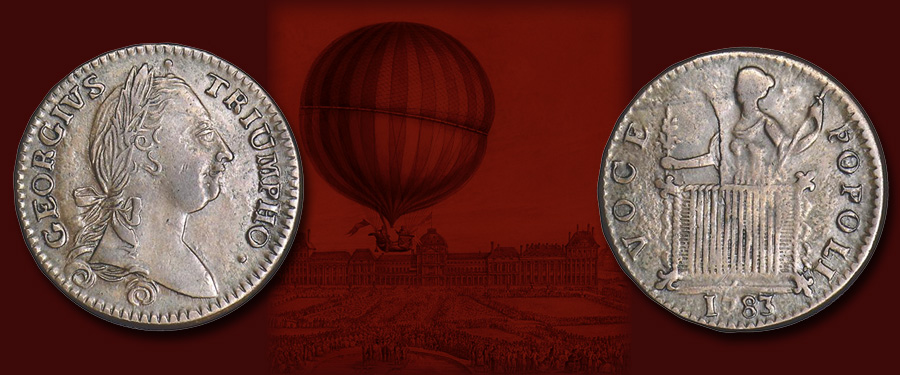
One of my favorite pieces of Americana is the 1783 Georgius (also spelled Georgivs) Triumpho (also spelled Trivmpho) token in copper. The obverse depicts a portrait of King George of England, with the inscription just mentioned. However, King George was hardly “triumphant” in 1783. In fact, this is the year that the treaty was signed ending the American Revolution, which England lost. The final battle of the war had been at Yorktown in 1781.
The reverse shows a figure behind a grill of 13 bars, with fleur de lys at the corner, the emblem of France, seemingly reflective of the aid of France and Lafayette to America during the conflict. In more recent times John Pack and a couple of others have thought that the reverse shows a figure ascending in a balloon. A chapter on this interesting token will appear in Coins and Collectors: Golden Anniversary Edition, to be published by Whitman later this year.
Relative to this a letter recently arrived from P.T., a New Jersey collector, which stated:
“I read your article on the Georgivs Triumpho a while back and was so intrigued by it that I needed one to represent a Washington piece for my colonial collection. Ray Williams was our guest at a coin club meeting and gave a presentation on these pieces. I told him I was interested in the Georgivs Triumpho. He referred me to Jack Beymer and I purchased one from him.
“The purpose of my letter is to agree with John Pack that Liberty is indeed aloft in an air balloon gondola on the reverse. I’ve read authors’ descriptions of it as a: 13-bar cage, a fence, framework, a weaving frame — without any reason. My reasons are that the first manned balloon flight was in Paris, November 21, 1873. The enthusiasm and frenzy this caused was overwhelming. Everyone was talking and singing about ballooning. It was like a man landing on the moon (which by the way it led to). So it feels natural, in my thinking — why not make a coin or token celebrating this historic event and the September 19 Treaty of Paris, by having a symbol of a new country rising. Even if the token was made a few years later, by the time they came up with a design, they kept the 1783 date as a commemorative.
“That’s what makes this hobby so great, researching and talking about coins and meeting others with their ideas. I purchased your Guide Book of Civil War Tokens recently and can’t wait for the Hard Times token guide. I have some of each as examples of emergency money that was used during these times. I’ll never forget when you signed my copy of your History of Coinage in the elevator at the Boston Convention in November 2003.”





